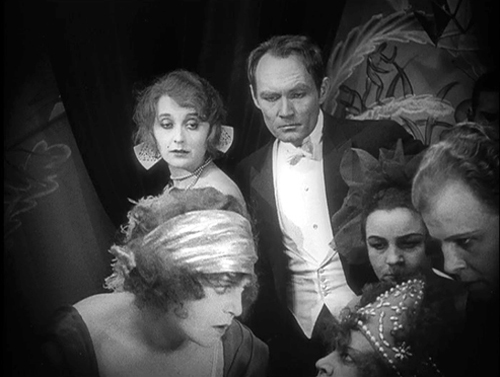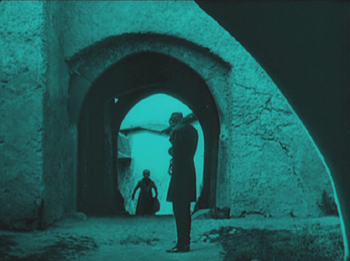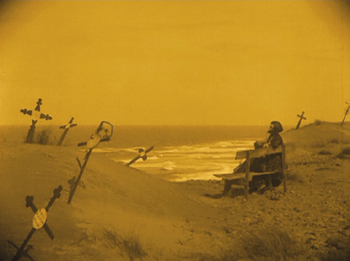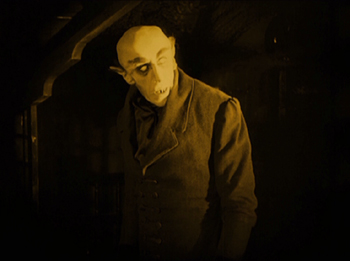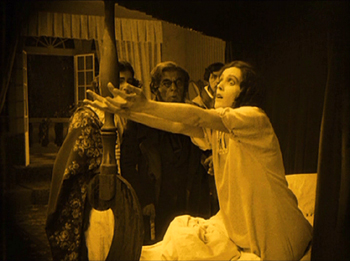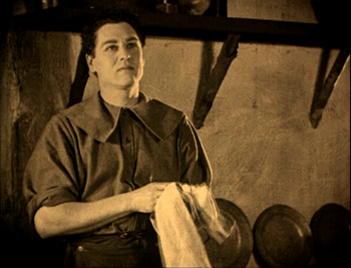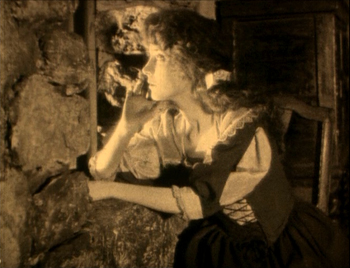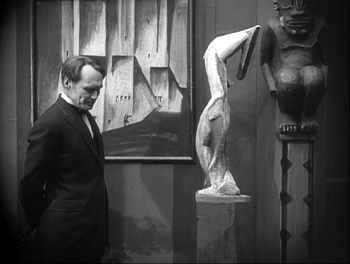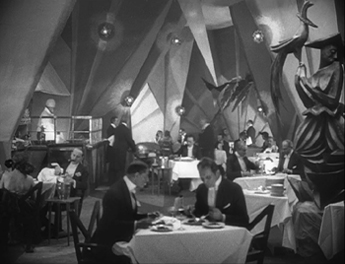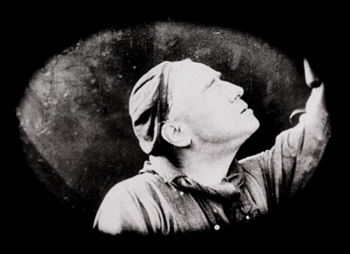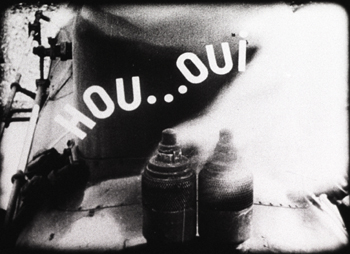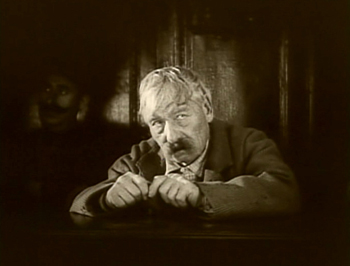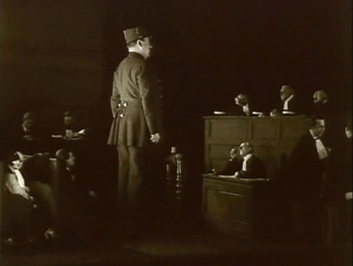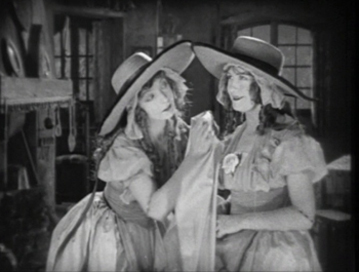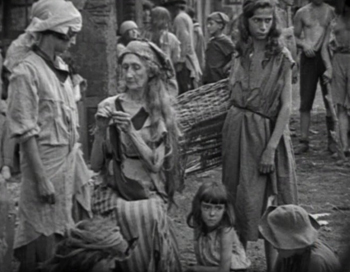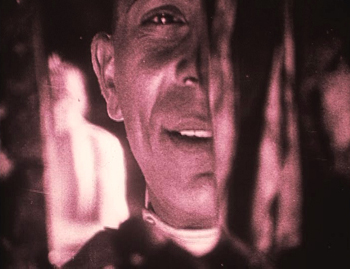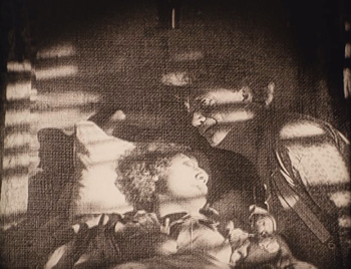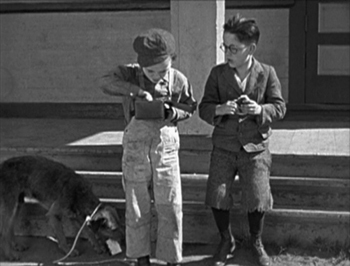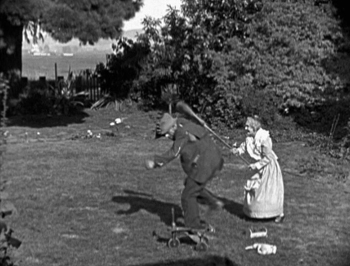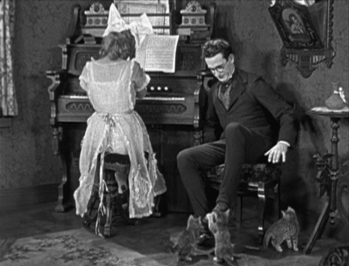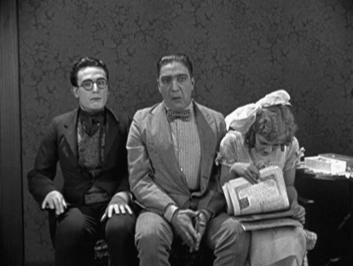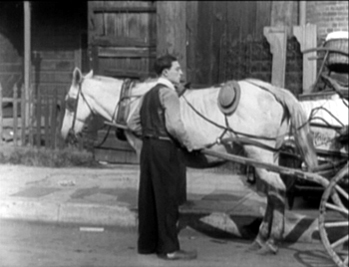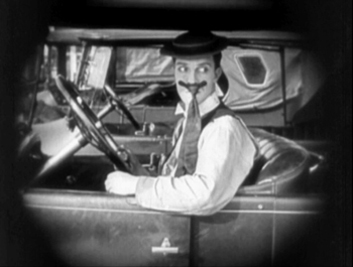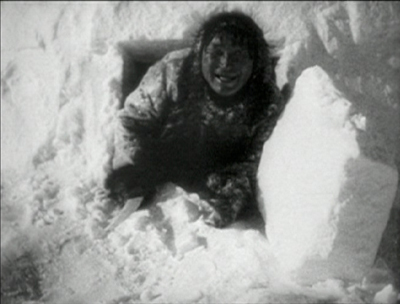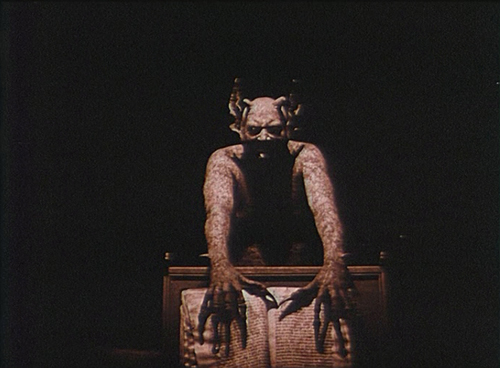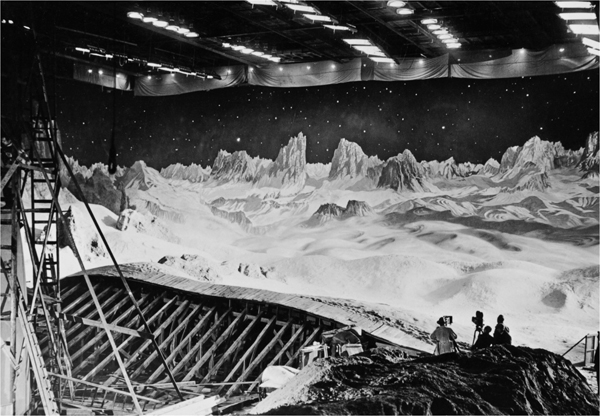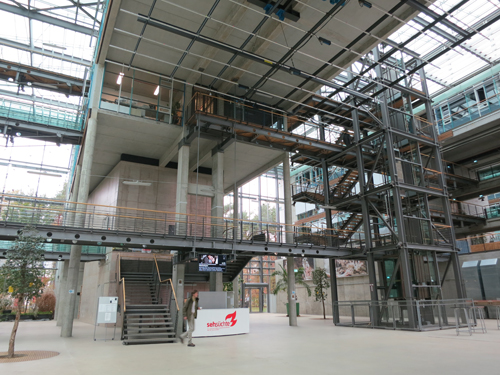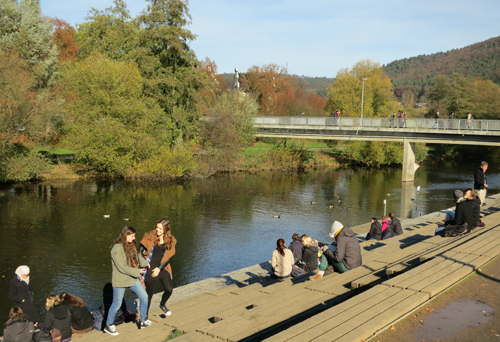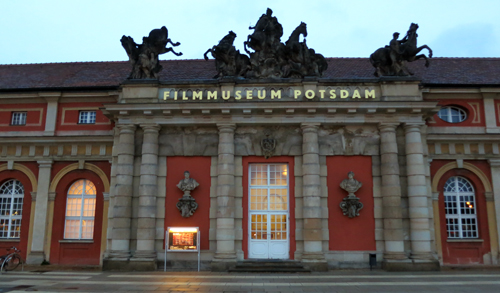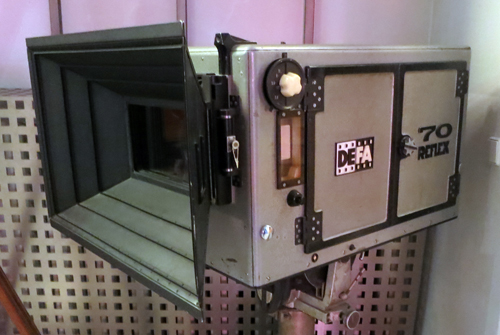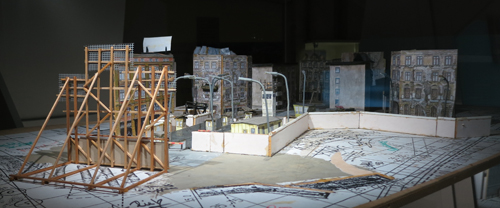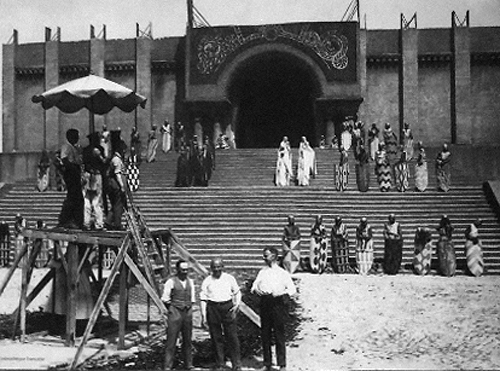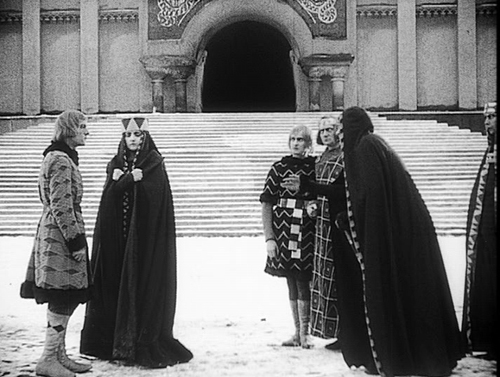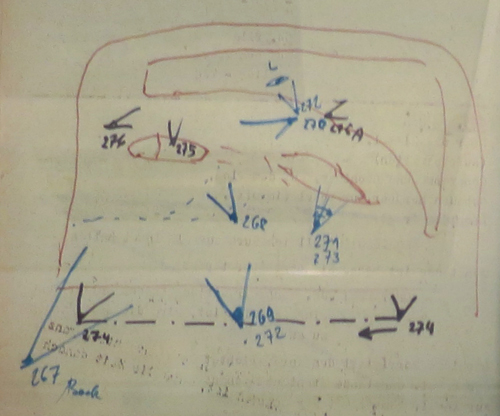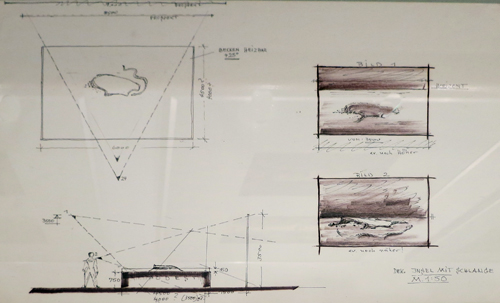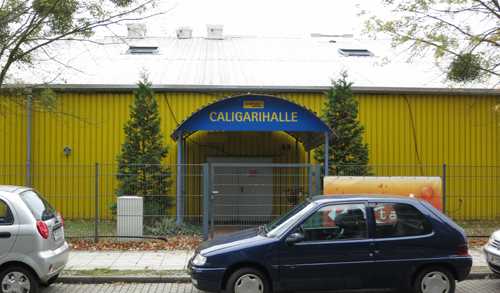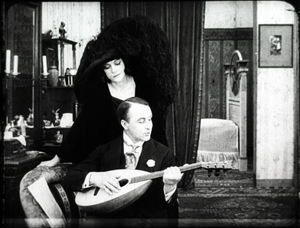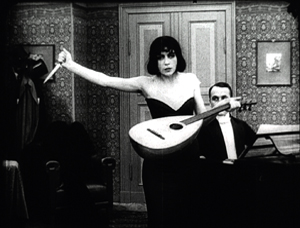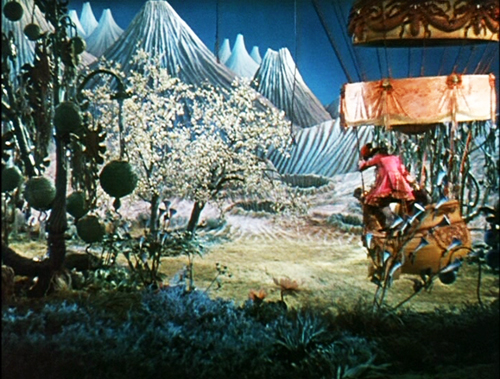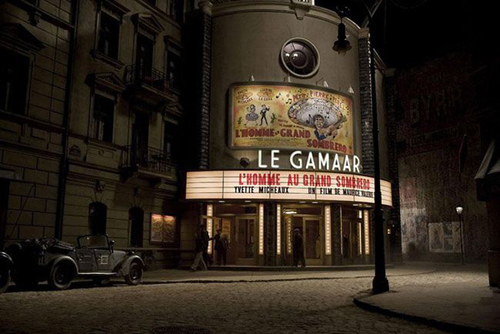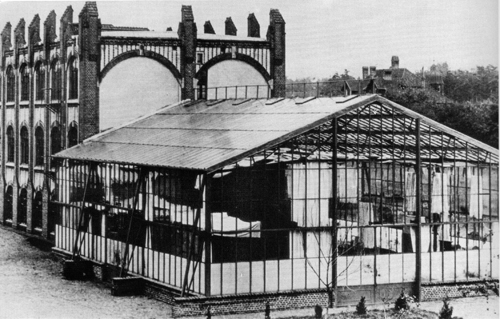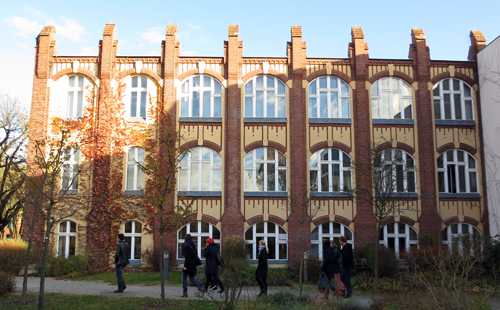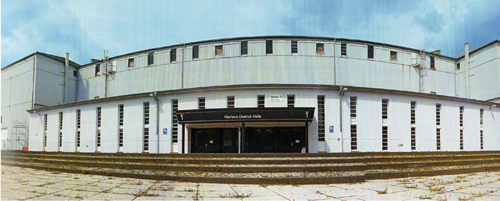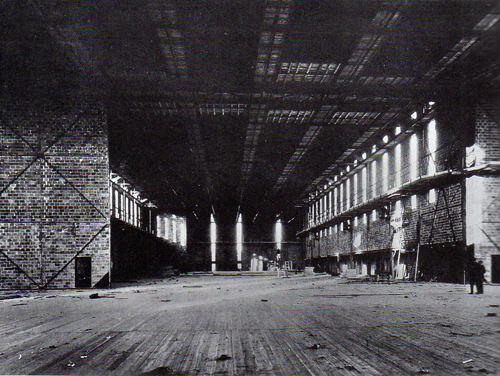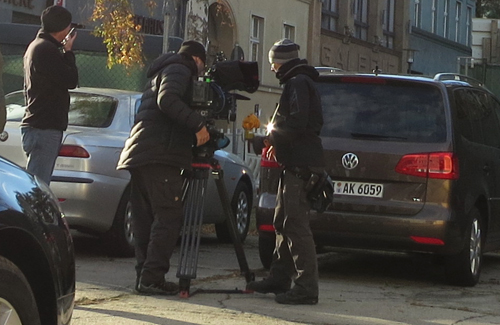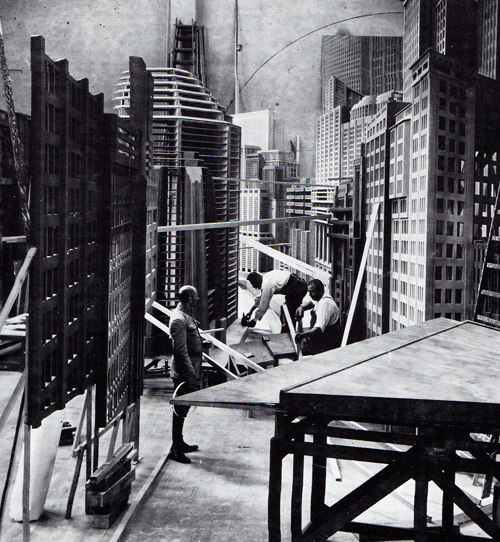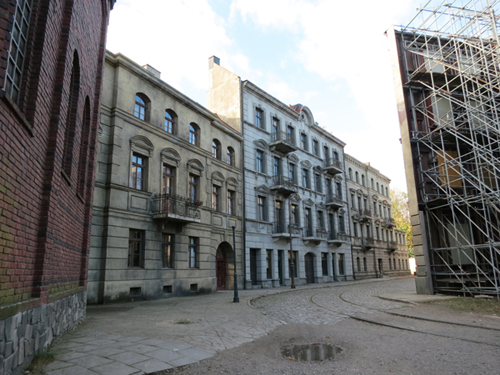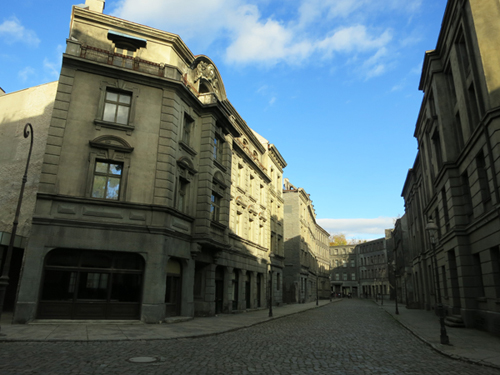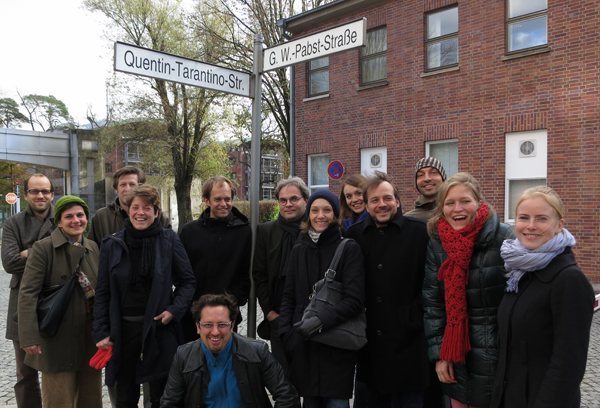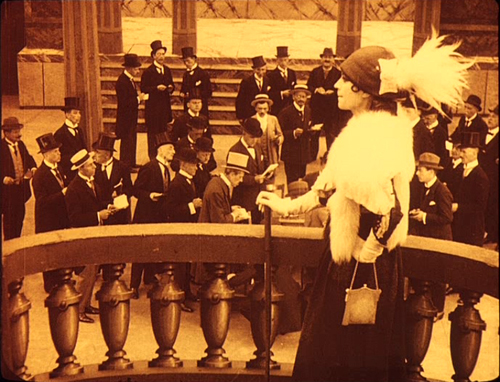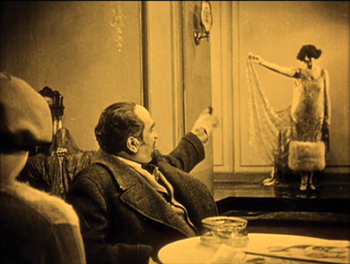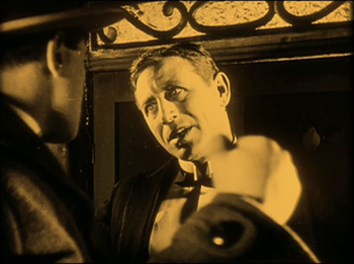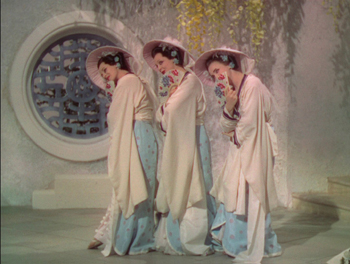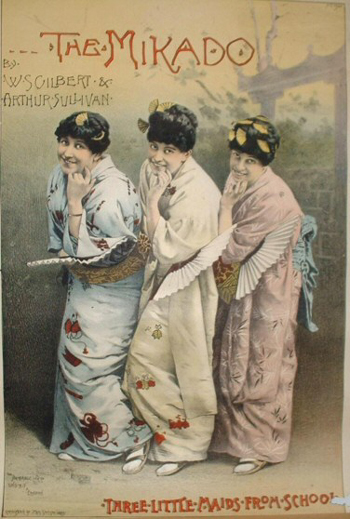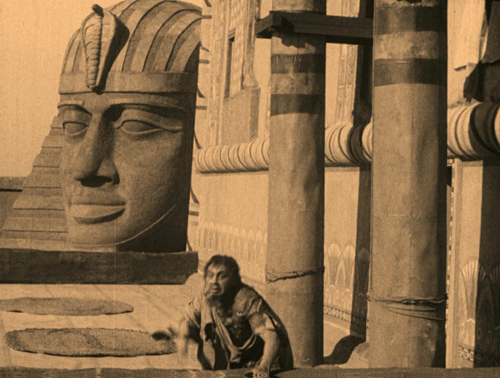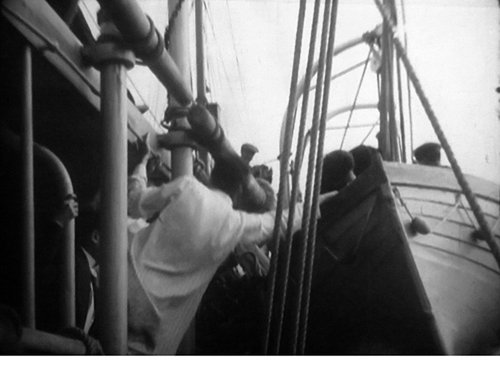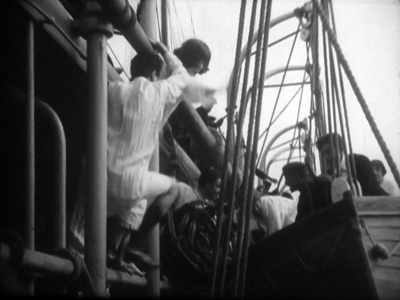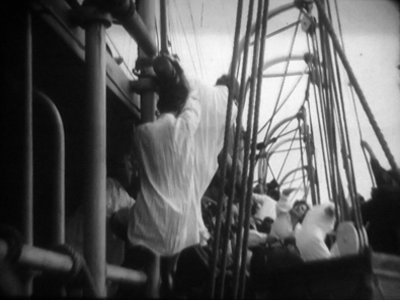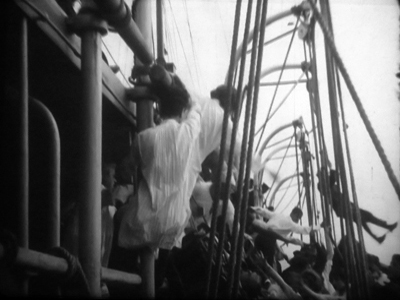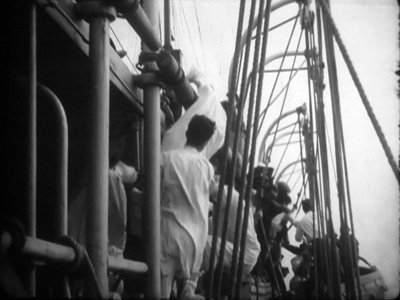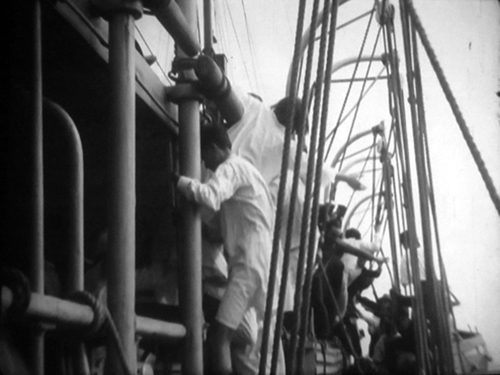Archive for the 'Silent film' Category
The ten best films of … 1922
Dr. Mabuse, der Spieler, Part 1.
Kristin here:
As the end of the year approaches and critics are posting their ten-best lists for the year, David and I once again fail to follow that tradition. Instead, we follow our own custom, now six years old, and turn our historians’ eyes back ninety years to offer ten great films from 1922. Of course, there are many films from the silent era that are lurking in archives, waiting to be discovered. Still, pointing to some noteworthy films we do have may help viewers to explore that rich period of cinema’s past.
Our previous lists can be found here, for 1917, 1918, 1919, 1920, and 1921.
For the past two years, I’ve noted that it was difficult to fill out the list of ten masterpieces. I keep thinking that I’ll get to a year where I won’t have to say that, but 1922 turns out not to be that year. Some titles were obvious, but the last one or two took some hunting.
As usual, one problem is that so many films are lost. Not one of John Ford’s three films of 1922 survives. In other cases great directors made lesser films. Important though Das Weib des Pharao was in Ernst Lubitsch’s career, partly because it shows him quickly picking up influences from Hollywood films, I can’t rank it among his first-rate titles. The same is true of Victor Sjöström, whose Vem dömer isn’t up to the level of other films like The Outlaw and His Wife.
Some of the films here, then, we consider classics but not masterpieces. Still, they have been influential and are well-regarded by other critics and historians. We’ll just call attention to them and let people form their own opinions.
Germany rules
But here are two full-fledged masterpieces, both from the German Expressionist movement. They demonstrate the potential for popular genres—here the horror and master-criminal genres—to achieve the highest level of filmmaking.
Few of F. W. Murnau’s early films survive, but there’s no doubt that he hit his stride in or before 1922. He made two outstanding films that year, Der brennende Acker (“The Burning Earth”) and Phantom, along with one of his very finest, Nosferatu. It is the earliest surviving film adaptation of Bram Stoker’s Dracula. (“Nosferatu” is Rumanian for “vampire.”)
Nosferatu is generally considered an Expressionist film, though there are only a few of the stylized sets that we tend to think of as vital to that artistic movement. Murnau instead mostly uses a combination of staging and framing in real locales to create echoes of shapes between characters and their surroundings, something usually accomplished through more painterly means in films like Das Cabinet des Dr. Caligari and Die Nibelungen. The nested arches in the left image frame Hutter’s arms, while Ellen’s forlorn slump on the bench as she awaits her husband’s return is juxtaposed with the leaning crosses that hint at fruitless vigils in the past.
One of my favorite moments in Nosferatu comes during the scene where Count Orlock is about to attack Hutter in one of the bedrooms in his castle. Ellen, at home in Wisburg, somehow senses this and in a panic throws out her arms in a desperate appeal for mercy. Orlock turns and looks away from Hutter, and the next shot again shows Ellen’s appeal.
It is a classic shot/reverse-shot situation, and yet the two are in different countries, many miles apart. The situation is ambiguous. Does Orlock sense Ellen’s appeal? Does he somehow magically see her from afar? Whichever is the case, he does leave Hutter’s room, and the clear implication is that her gesture has caused that withdrawal. Such a treatment of space is unusual, to say the least.
“False” eyeline matches or shot/reverse-shot passages linking distant characters were already fairly conventional. Hoping to put another of Maurice Tourneur’s films on our ten-best list, I watched his 1922 Lorna Doone. Though it has some marvelous passages, especially in the final battle, I couldn’t justify including it. Still, it provided a more conventional version of the false shot/reverse shot. In a scene where the hero thinks of Lorna, looking off front right, the following shot shows her thinking of him and looking off left.
They are in houses on neighboring estates, but they certainly cannot see each other. Moreover, there’s no indication that either suspects the other one is thinking of him/her. There is no ambiguity. Clearly the lovers are simply daydreaming about each other. The Nosferatu scene is more puzzling and evocative.
There is much more that once could say about Nosferatu—especially the experimentation with fast motion, negative footage, and pixillation to render the supernatural nature of the vampire—but I leave that for the reader to discover. There are a number of DVD versions available, but the Kino one contains the restored print and a documentary about the film’s production; the restoration is also available in the UK from Eureka!.
If this blog is still functioning in ten years, our list will definitely include a second great vampire film, Carl Dreyer’s Vampyr.
While Nosferatu plays on exotic, historic fantasy, Fritz Lang’s Dr. Mabuse, der Spieler (“Dr. Mabuse, the Gambler”) places its bizarre crime story squarely in contemporary Berlin. Mabuse (the incomparable Rudolf Klein-Rogge) is a master criminal with hypnotic powers, a man of innumerable disguises who lures his victims into gambling, whether in casinos or on the stock exchange. He also steals crucial documents to manipulate stock prices and controls the lives of many of the main characters. Throughout the lengthy plot, Detective von Wenk follows Mabuse’s trail, himself eventually falling under the criminal’s spell before exposing Mabuse’s identity.
Unlike with Murnau, we now have all of Lang’s early films and can judge his entire career. Arguably his first great film was Der müde Tod, which was on last year’s list. The first of his three Dr. Mabuse films (the others being Das Testament des Dr. Mabuse, 1933, and his last film, Die tausend Augen des Dr. Mabuse, 1960) was a step upward. It was made as a two-part serial: Der grosse Spieler—Ein Bild der Zeit (“The Great Gambler—A Picture of the Time”) and Inferno: Ein Spiel von Menschen unserer Zeit (“Inferno: A Play about People of Our Time”); together the parts run about four and a half hours.
The plot of Dr. Mabuse, der Spieler is very complicated and demonstrates Lang’s extraordinary ability to present a narrative visually. His sets, lighting, and staging are impeccable and already recognizably Langian. Consider the frame at the top of this entry.
In a gambling den, von Wenk, at the center top, and two important female characters, Countess Told, beside von Wenk, and Cara Carozza, left foreground, are staring at a rich old lady who has just gambled away a huge amount of money, caught by Mabuse’s spell. Her loss is the central action, yet she is placed so low in the frame as to be recognizable primarily by her silly beaded hat. Her gigolo, partly offscreen at the right, considers his position in the light of this disaster. Cara reacts with horror, the Countess and von Wenk with distress and sympathy. The other woman is an onlooker.
The tableau style of staging, keeping all the significant characters onscreen and moving them by slight increments to stress each character in turn, is still in play here, but the camera is closer to the actors, and they don’t move much. This isn’t just a tiny moment caught in the midst of a shifting composition. This is the composition. It looks remarkably modern. Each character, in his or her own way, is wondering, as we are, what has brought this minor character to such a pass. And she is tucked into a corner of the frame, as Lang will do in later films.
Dr. Mabuse‘s stress on “Our Time,” contemporary Weimar Germany, brings in the film’s Expressionistic elements. Expressionism here isn’t an all-encompassing filmic treatment that reflects a fantasy world or the psychological extremes of the characters. Instead, it is a tangible decorative impulse pervading the modern city. Below, von Wenk responds with distaste upon first viewing Count Told’s collection of modern art; yet in another scene, he calmly dines with an associate in a thoroughly Expressionist restaurant:
The bits of set visible in the background of this entry’s top frame indicate that the casino is another Expressionist locale.
The restored two-part film is available from Kino in the USA and in “The Complete Fritz Lang Dr. Mabuse Box Set” and from Eureka!’s “Masters of Cinema” series in the UK.
The grandiose and the modest as French Impressionism defines itself
The French Impressionist film movement can be said to have begun in 1918 with Abel Gance’s La Dixième Symphonie, though it has relatively few moments of the sort that came to define the style. It primarily uses superimpositions and split screen to convey a sense of the composer’s musical performances. Films by critic and theorist Louis Delluc followed, and Marcel L’Herbier explored pictorial and poetic effects in his early films. Highly subjective uses of film technique, which we think of as crucial to Impressionism, appeared in a really consistent way in El Dorado (1921), which was the first film of the movement to appear on our ten-best lists.
In 1922, the movement gained momentum with Gance’s monumental La roue. Many critics and historians consider this and Gance’s Napoléon masterpieces. I consider them more uneven, with brilliant stretches mixed in with melodramatic, sentimental, even occasionally maudlin scenes mixed in. Few people have seen all the surviving footage from La roue. The shorter versions available tend to eliminate the sentimental bits, which often run on and on. I’ve already voiced my opinions, favorable and less so, in the entry “An old-fashioned, sentimental avant-garde film,” posted when the longest version available on DVD was released by Flicker Alley.
I mentioned there that the footage cut from the shorter versions of the film seemed to be some of the sentimental moments. One such scene seems to me unintentionally risible. The hero, Sisif, is a veteran train engineer; he has suffered an injury that is slowly causing him to go blind. Unable to face turning his beloved engine over to a rival engineer, he ponders destroying it. Sitting on the engine, he asks whether it would not prefer being wrecked to being turned over to another driver. The replies to his questions are given as titles superimposed over the train:
This is, I think, representing Sisif’s delusion that the engine speaks to him, but I’m afraid it comes across as if the train is suddenly talking out loud. In a sound film it’s easy to understand that a sound can originate subjectively in the mind of a character. People don’t, however, tend to imagine sounds as written words!
There’s no question that La roue has some extraordinary scenes. The opening train wreck and its aftermath are justly famous, as is the accelerating editing in the scene in which Sisif drives his stepdaughter Norma, with whom he is secretly in love, into the city to marry another man; his agitation and thoughts of crashing the train are reflected by the increasingly shorter shots. And although it’s dangerous to make claims about any film having the first use of a given technique (usually someone will find an earlier one), Gance seems to have been the first to use stretches of single-frame editing. These occur at a moment when one character in a crisis situation (trying to avoid spoilers here) recalls a cluster of scenes from his past. Maybe the Soviet Montage directors would have come up with that idea on their own—but maybe not. Along with El Dorado, La roue helped define what were to be the main traits of Impressionism.
One thing I didn’t mention in my entry on La roue is the striking contrast between the romance plot and the many scenes shot around the train-yard, which were shot on location. They add a gritty realism that does much to make up for the melodrama—a realism that largely disappears in the final portion, when Sisif is transferred to a mountain location to run a funicular train.
Most of the French Impressionist directors, and particularly Gance, L’Herbier, and Delluc, were concerned to prove that cinema was an art form. Their films tended to be serious, poetic, and based more on in-depth psychological portraits than on the more action-oriented films of Hollywood. They were also clearly made by Artists with a capital A. Gance and L’Herbier liked to start their films with close-ups of themselves staring into the lens with artistic fervor. L’Herbier’s photos included autographs. The films were designed to appeal to an intellectual crowd, though Gance’s were also highly successful at the box-office. Other directors’ films weren’t hits, however, and as the decade progressed more of them played only in the ciné-clubs and art theaters that sprang up.
Another Impressionist film of 1922, Jacques Feyder’s Crainquebille, took a very different tack. I remember seeing Crainquebille decades ago and not thinking much of it, though it has long been considered a classic. Now, however, watching the 2005 restoration by Lenny Borger and Lobster Films, I think it’s much more interesting. That’s not surprising, given that the print I originally saw was probably the 50-minute American release version, and the restoration adds half again as much footage, bringing it to 76 minutes. (The Internet Movie Data Base lists the original Belgian release print as 90 minutes, so presumably what we have is still not complete.)
Crainquebille has been admired for its realism and for the performance of a well-known stage actor of the day, Maurice de Féraudy in the title role. Jérôme Crainquebille is an elderly vegetable peddler, and much of the film was shot in the streets and markets of Paris, sometimes using long lenses to capture scenes of crowds and passers-by, unaware of the camera’s presence. But what struck me upon seeing it again is that Feyder was trying to make an Impressionist film for ordinary cinema-goers, perhaps the working-class people who could relate best to Crainquebille’s situation and milieu.
True, the film has a prestigious pedigree, being an adaptation of an Anatole France novel and starring a famous theater actor. Yet the story is simple and told in a relatively straightforward manner. Most of the action arises from a misunderstanding: A gendarme, thinking Crainquebille has insulted him, arrests him. A leisurely scene shows the protagonist enjoying the unusual luxury of his prison cell: a comfy bed, free meals, a toasty radiator, hot and cold water in a pristine sink, and a floor clean enough to eat off. A working-class audience would probably find this wryly amusing.
More telling, though, is the fact that when the typical camera techniques of Impressionism are used, Feyder inserts explanatory intertitles just before the subjective shots occur. This particularly happens in the long central trial scene. When the gendarme steps up to testify, a title informs us, “In Crainquebille’s eyes the Constable looked as important as his testimony.” We see Crainquebille gazing forlornly off right front and then his point-of-view of the witness, looming like a giant over the courtroom:
Subsequently a passerby from the scene of the “crime,” Dr. Mathieu, testifies on Crainquebille’s behalf. A title informs us, “To Crainquebille this testimony seemed to carry little weight.” We see a similar pair of shots, with the witness a tiny figure in the midst of the court. Naturally Crainquebille is found guilty and goes off to two further weeks of free room and board.
The next scene begins with an intertitle, “Dr. Mathieu’s Nightmare.” We see Mathieu in bed and then are taken into his nightmare, which depicts the court as a stylized, hellish place with the judges fearsome figures who leap onto their desk in extreme slow motion. (I have no way of knowing what the source of these intertitles is, so I must simply assume here that they reflect what was in the original film.)
Such heavily signaled experiments wouldn’t in themselves make Crainquebille a real masterpiece, but at a time when Impressionism was just gelling as a recognizable style, it seems a laudable attempt to find a non-elitist way to use it. In addition, the shots of the market where Crainquebille goes each morning are quite lovely, taken from neighboring rooftops with telephoto lenses.
As to what was restored in this version, there is remarkably little information on the internet. My notes from an archive viewing of the shorter version in 1984 suggests that the entire opening sequence in the restored version is “new.” It consists of Crainquebille and other vegetable peddlers pushing their carts across Paris to the main market. They pass through a wealthy district, which is characterized with vignettes of rich people’s decadence. The peddlers then pass through a high-crime district, with police rounding up criminals and prostitutes. (The inclusion of prostitutes suggests why this scene was cut for the American version.) The shorter version begins with the market scene and leads quickly to a scene in which Crainquebille rescues a poor newsboy from bullies, and the the scene where he is arrested follows. The entire character of Dr. Mathieu, the sympathetic witness, was cut, so the short version has a briefer trial scene and no nightmare. The action that follows Crainquebille’s release from prison is the same as in the restored version.
Crainquebille is available as part of a set, “Rediscover Jacques Feyder French Film Master,” along with restored versions of two of his other major films of the period, L’Atlantide (as “Queen of Atlantis,” 1921) and Visages d’enfants (as “Faces of Children,” 1925).
Hollywood dramas: The somewhat old and the somewhat new
The two Hollywood films on this year’s list are very familiar Hollywood classics, so I won’t spend much time introducing them.
D. W. Griffith probably appears for the last time in our 90-year-ago lists with his historical epic, Orphans of the Storm. This tale of the French Revolution featured the last appearances for Griffith of Lillian and Dorothy Gish, whose first film roles had been in his American Biograph short, An Unseen Enemy, in 1912. They play apparent sisters, Henriette and Louise (though Louise is in fact adopted) living in a Normandy village. Louise becomes blind, but Henriette takes her to Paris in the hope of finding someone who can restore her sight. Upon arriving, they are separated and victimized, Henriette by the decadent nobility, Louise by the dishonest poor. Eventually they are caught up in the Revolution, and Henriette is nearly executed at the guillotine.
As in his best features, Griffith combines an ability to represent melodramatic stories of idealized, virginal heroines alongside naturalistic, convincing images of the poor:
Orphans of the Storm represents the lingering influence of the Victorian theater on Griffith. The slightly later Naturalistic strains of nineteenth-century literature are evident in the cynical narratives of Erich von Stroheim. His first film, and the most completely preserved, was Blind Husbands, featured in our 1919 ten-best list. As I said there, Blind Husbands is my favorite von Stroheim film, with its relative light take on attempted seduction, near marital infidelity, and retribution. Foolish Wives took the theme much further, with the director again playing the heartless rake, Count Wladislaw Sergius Karamzin. Rather than pursuing one vulnerable wife, he seduces every woman in sight, including a hotel maid and an invalid, bedridden girl (above whose bed a crucifix hangs, to make sure we grasp the sinfulness of Karamzin’s lust).
Von Stroheim famously reconstructed the casino and surrounding buildings of Monte Carlo, resulting in a budget overrun. Universal made the best of his profligacy by advertising Foolish Wives as the first million-dollar movie ever. (Whether it really was or not we shall probably never know.)
Although much of the film is fairly conventional, with shot/reverse-shot conversations, von Stroheim experimented occasionally. At the left below, he shoots into a small mirror as Karamzin secretly ogles the heroine, who is behind him, as she undresses. In a number of shots von Stroheim films through a scrim to give a canvas-like effect to a composition. Here the invalid girl whom the villain eventually tries to rape is seen with her doting father.
As with all of von Stroheim’s films after Blind Husbands, Foolish Wives was taken out of his hands by the studio and shortened considerably. Much of this was done by trimming the lengths of individual shots. The original film apparently does not survive, so it is impossible to assess the director’s style thoroughly, especially when it comes to editing. The revisions were not nearly as great, however, as with his 1924 film Greed, which was cut by well over half. Thus of all von Stroheim’s 1920s films, Foolish Wives is probably closer to what he intended than most. The standard version of the film (restored by the American Film Institute but not of sterling visual quality) is available from Kino in an edition that includes a 78-minute documentary, The Man You Loved to Hate, written by von Stroheim expert Richard Koszarski.
Hollywood silent comedy
Every year our list visits the great three slapstick comedians: Chaplin, Keaton, Lloyd. Sometimes it’s all three, sometimes two. They have all been working their way through shorts to the great features of the 1920s. Chaplin made it there last year with The Kid. In 1922 he had a light year, reverting to two-reelers with The Idle Class and Pay Day, so we’ll skip him here and pick him up again later.
In 1922 it was Harold Lloyd who moved up to features with Grandma’s Boy. Not on a level with some of his later films, like Girl Shy (sure to be high on our 2014/1924 list), but a real charmer with some classic Lloyd routines.
Lloyd is undoubtedly best known for his “thrill” comedies like Safety Last (1923 and heavily favored to feature on this list next year), where he climbs a skyscraper. Still, his more typical roles in the features show him beginning as a timid or socially inept young man who gains courage or skill in the course of the narrative. In Grandma’s Boy, an amusing and touching scene introduces the hero as a perpetually frightened child, unable to stand up even to littler boys who steal his lunch. Once he has grown up, his diminutive grandmother manages to chase off an intruding hobo with her broom after the Boy (none of the characters is named) has failed do so:
Despite his timidity, the Boy has managed to attract a Girl, and a Lloydian string of gags occurs when she invites him and his thuggish Rival to visit her at home. Grandma polishes the Boy’s shoes with goose grease and dresses him in an antiquated suit with mothballs in the pockets. Once at the Girl’s house, the Boy attracts the unwanted attentions of a litter of kittens determined to lick his shoes. When the Girl reacts badly to the mothball-scented suit, the Boy hides the balls in a box of candy. This leads to a hilarious scene in which he and the Rival both accept some “candy” from the Girl and end up grimacing in sync and trying to smile every time the Girl glances at them.
As with many good classical films, almost exactly halfway comes a turning point: the sinister hobo has robbed a jewelry store and shot a man. The film’s second half becomes an extended chase in which the reluctant Boy is enlisted as a deputy. Thanks to a little psychological trick played by the Grandmother, he wins out.
Grandma’s Boy is available in the indispensable “The Harold Lloyd Collection,” one of New Line Home Entertainment’s finest achievements, or separately with some other features as Volume 2 of the same set, or even more separately with seven shorts from Kino.
Buster Keaton was still making shorts in 1922, but this doesn’t put him at a disadvantage in our list. Experts agree that of Keaton’s twenty starring shorts (after his work as sidekick to Fatty Arbuckle), the best are The Boat (1921) and Cops (1922). Both are strongly touched by the streak of surrealism that frequently shows up in Keaton’s work—as in the dream-within-a-film scene that forms the bulk of Sherlock Junior (1924).
In Cops, Keaton plays a young man trying to impress his beloved by making good in some fashion. He is duped by a crook pretending to be evicted, who sells him the furniture of a family moving house, along with the horse and wagon that has come to transport it. Taking off through the city with the furniture he intends to resell at a profit, Keaton finds himself in the midst of a police parade and innocently accused of throwing a bomb actually lobbed by an anarchist. Chaos breaks loose. No matter where our hero runs, everyone he encounters turns out to be a cop—including his sweetheart’s father and the owner of the furniture.
The film is full of wonderful sight gags. Keaton hangs his hat on the protruding hip bone of a scrawny horse, and he tries to make a mustache disguise out of a clip-on tie.
Cops is available in Kino’s collection of Keaton shorts and in its collection of most of the features and shorts. Also available in the UK in the Eureka! “Masters of Cinema” box set of all Keaton’s shorts.
Next year, Our Hospitality!
Documentary and storytelling
Although we’re not overwhelmed with admiration for our final two films, they demanded inclusion because they are recognized as canonical classics.
Nanook of the North has frequently been described as the first feature-length documentary. Here’s an example where it was dangerous to call something first. There is in fact at least one earlier, filmed at the opposite end of the Earth: Frank Hurley’s South (1919), a record of Ernest Shackleton’s famous shipwrecked expedition to the Antarctic. But Nanook found a much wider public and became a classic, while South disappeared until 1998, when it was restored by the British Film Institute.
Nanook also had the advantage of a charismatic central figure and his attractive family, a picturesque depiction of Inuit life, and a carefully scripted story that included moments of danger during a walrus hunt and humor during a visit to a trading post.
Still, the film has drawn criticism for its extensive manipulation of reality. “Nanook” was in fact an Inuk named Allakariallak, and the woman represented as his wife was not married to him. Scenes were staged, as when an already-dead seal was used in a hunt. Nanook expresses amazement at a phonograph, though he was already familiar with such devices. The Inuit had already adopted firearms for hunting by the time Flaherty filmed them, but he requested that they use spears instead.
As has been pointed out, however, Flaherty was trying to present a slightly earlier phase of the Inuit culture, preserving a lifestyle that was rapidly changing. Moreover, the documentary mode had previously consisted largely of actualities and travelogues, and there was little precedent for what Flaherty was doing. For decades after Nanook (originally subtitled A Story of Life and Love in the Actual Arctic), documentaries tended to be structured fairly explicitly as tales with entertainment value. In the wake of cinéma vérité, the issue of filmmakers interfering with their subjects and staging scenes has become controversial, but it was not a great concern in the 1920s.
If we accept the notion that this is a documentary with considerable manipulation, we can credit the film with conveying a good deal of information about the Inuit of a slightly earlier period. The igloo-building scene is interesting and informative, even if we know that the interior shots had to be made in an igloo actually open on one side to provide light for the camera.
Nanook of the North was restored and released by the Criterion Collection in 1999.
Although it also appeared in 1922, Benjamin Christensen’s Häxan tends not to get equal credit as the supposed first feature-length documentary. Perhaps that is because it barely qualifies as a documentary. It’s not clear what other genre or mode it belongs to, though it tends to be admired mostly by fans of horror films.
Häxan purports to be a lecture on the history of witchcraft. Its English title is Witchcraft through the Ages, though the original title means simply “Witches.” The first reel consists of a series of images from books both scholarly and sensational, showing ancient images of supposed witches or witch-like creatures. The claim is that witchcraft has been a universal concept in cultures throughout history. Whether this is true I can’t say, but the images shown of ancient Egyptian deities are not witches but protective figures.
In the second reel, Christensen begins to illustrate the points being made with staged scenes of witches, surrounded by animal skeletons and other macabre items, many of them used in potions. Gradually the staged scenes develop into a narrative set in the Medieval or early Renaissance era, with one old woman being accused of witchcraft and tortured. She finally admits to being a witch and names her accusers as witches, and the imprisonment and torture spread. Like Dreyer in Leaves from Satan’s Book and Day of Wrath, Christensen condemns the very notion of witch-hunting and the hypocrisy and cruelty of the Church. Yet he shows a considerable fascination with torture methods—although in place of graphic scenes he presents static shots of contorted limbs and exhausted victims.
The true strangeness of the film, however, comes from its visualization of demons and devils as real beings. They conducting orgies, fly on broomsticks, and attempt to seduce people into evil and madness. Perhaps we are to take these images as what the Church assumes is happening, but there is no indication of that. One has to suspect that ultimately the educational “lecture” premise of the film, which is handled in a perfunctory way, is an excuse for staging scenes that range from quite powerful (see below) to merely cartoon-like, with people dressed up in crudely made costumes.
At the end the lecture mode returns, with an unconvincing series of comparisons of witchcraft with modern-day activities.
Whatever one thinks of the subject matter and its treatment, the film’s cinematography is extraordinarily beautiful.
Häxan has been restored by the Svenska Filminstitutet and was released on DVD with optional English subtitles. The restoration is available in the USA from the Criterion Collection, but I haven’t seen it or its extras. The Criterion package includes a version of the film narrated by William S. Burroughs. I haven’t seen it, but according to David’s memory of the croaky, world-weary voice-over, it adds another layer of weirdness to the proceedings.
For many years Häxan, as the only film by Christensen that was available for viewing outside archives, gave a rather distorted view of this director. Then his two earlier films, Det hemmelighedsfulde X (“The Mysterious X,” 1914) and Hævnens Nat (“Night of Revenge,” 1916) became more widely available. They were revelations—beautifully shot, tightly scripted, exciting movies. Those who don’t like Häxan should definitely watch these; they are quite different. Both are available on a single DVD from the Danske Filminstitut. The DVD has English intertitles, and the online shop is bilingual, Danish and English.
Häxan
Germany in autumn, in style
Shooting Frau im Mond (1929) at Neubabelsberg studio, Potsdam.
DB here:
Friends say that Berlin is now the most exciting city in Europe–a little too exciting, others say. I can’t prove either claim, but I can declare that I had a fine time last month during my second visit to Germany this year. Part of the fun was, as usual on many of our trips, finding tangible traces of film history.
Stylin’
Lobby space, Konrad Wolf Film School.
With Michael Wedel, I re-saw Hong Sang-soo film’s Turning Gate in the wonderful Arsenal theatre, part of the Deutsche Kinemathek. The Arsenal is run by Milena Gregor, another old friend (who happens to be Michael’s wife). On another night I also had a delicious dinner with filmmaker Christine Noll Brinckman and other friends. Then there was a pleasant lunch with another filmmaker, Carlos Bustamante (below), in his picturesque neighborhood.
But Berlin literally wasn’t the half of it. I visited Philipps Universität in Marburg, a charming university town. Part of the campus fronts onto the Lahn River, and it makes a charming place to relax.
After my lecture on 1940s Hollywood, my hosts Malte Hagener and Dietmar Kammerer took me out to dinner with their lively colleagues.
Most of my visit was spent in Potsdam, where I’d been invited by the Netzwerk Filmstil. This is a research team composed of several young professors teaching in German-language universities around Europe. Their focus is the exploration of style in audiovisual media–centrally film, but not ignoring television, video games, Internet pieces, and even surveillance and security videos. The two and a half days of the seminar were very stimulating. Michael Wedel, Chris Wahl, Malte, Dietmar, and Kristina Kohler gave illuminating papers on (respectively) digital sound, superimpositions, split screen, freeze-frames, and dance in silent film. The participants offered me good criticisms of my presentation, which explored how E. H. Gombrich’s explanations for stylistic change in visual art might apply (or not) to cinema.
Our seminar sessions were held in the remarkable Konrad Wolf Film School, a towering building crisscrossed by staircases and walkways. I visited it once before some years ago, and once more I admired its airy yet rectilinear architecture.
The stripped-metal look is offset by lots of glass–the light pours in from all directions–and a corner with plenty of plant life. As in our house back home, winged silhouettes on the windows keep bird-brains from flying into the glass.
I also gave a talk on film style during the 1910s at the monumental Filmmuseum Potsdam.
The museum holds a fine screening space and a fascinating collection of historic materials, including a Soviet-era 70mm camera.
The current exhibition was devoted to the rise of the film studio Babelsberg, not far away. The displays included scripts, set photos, production sketches, photos, and maquettes.
Have you seen this still of the great Cathedral set from the Nibelungen?
The tradition of fastidious planning created during the silent era persisted into the period of the German Democratic Republic. Each set design was marked up to show camera positions (numbered), lens lengths, and special-effects elements.
The Filmmuseum’s collection was only one reminder of the towering importance of Babelsberg, now celebrating its hundredth anniversary year. Luckily the studio was an easy walk from the Konrad Wolf school. One sunny day our host Michael Wedel took the Style Network on an insider’s tour.
Babelsberg’s birthday
The 1910s and 1920s saw many production facilities spring up in Germany. Films were made in Munich, Frankfurt, and other major cities, and the area around Berlin boasted a number of studios. But the Potsdam facility, initially called Neubabelsberg, became the most well-known, something like Europe’s answer to Hollywood.
Founded by the Deutsche Bioscop company, the studio began production in 1911 and released its first film, Totentanz (The Dance to Death), in 1912. That starred Asta Nielsen, whose popularity had already enriched Bioscop. In this story she’s attracted to a rather louche composer, as we see below. (Yes, that mass of black is mostly her hat.) Later, she slices the guitar strings in a fit of passion and glares out defiantly at us. As if our attention might wander.
Neubabelsberg was home to such classics as The Student of Prague (1913), the Homunculus series (1916-1917), Madame Dubarry (1919), The Cabinet of Dr. Caligari (1920), The Golem (1920), and Genuine (1920). Fairly soon Bioscop merged with Erich Pommer’s Decla, and in 1921 the big company Ufa took over the facility and the resident firms. Ufa also had a studio in Tempelhof, a Berlin suburb, but the attention-grabber was Neubabelsberg, which became a sprawling complex of 350,000 square meters–the biggest studio in Europe.
Here Murnau shot Phantom (1922), as well as portions of The Last Laugh (1924). E. A. Dupont filmed some of Variety (1925) here, and Pabst shot all of The Loves of Jeanne Ney (1927) on its stages. Above all, Neubabelsberg helped sustain one of cinema’s great hot hands, the string of films Fritz Lang made in the 1920s: Destiny (1921), the Mabuse duo (19221-22), the Nibelungen saga (1924), Metropolis (1927), Spies (1928), and Woman in the Moon (1929).
The studio remained a powerful force across the next two decades, from The Blue Angel (1930) to the epic color production The Adventures of Baron Munchausen (1943).
The partitioning of Germany after World War II put it the studio the eastern sector, and the new state-sponsored film company, DEFA (Deutsche-Film-A. G.), took over the facility in 1953. That made it what Ralf Schenk calls “the exlusive site of feature cinema production in the GDR until 1990.”
After the Wall came down, the Babelsberg studio revived itself as a facility for international productions. It has hosted films by Polanski (The Pianist, The Ghost Writer) and Tarantino (Inglourious Basterds; below, a set on the Babelsberg backlot). The Wachowskis have been loyal supporters, with Speed Racer, V for Vendetta, and most recently Cloud Atlas using the facility.
You can get a sense of the studio today by visiting the website, which presents it as a modern resource for world filmmaking. But its early years matter more to me. To walk these quiet pavements and to imagine following in the steps of Lang, Jannings, Dietrich, and other legends ought to thrill any cinephile. Seeing some streets named for the greats, Tarantino requested a street in his name. It’s apparently a dead end.
A new Babylon
In the cold winter of 1911-1912, Deutsche Bioscop built its first studio, a 45 x 60 foot “glass house”at Babelsberg.
Michael Wedel explains:
Not only was a special cement-less glazing developed for the glass, but even the supporting beams of the infrastructure had to be installed outside of the studio, so as not to spoil the sunlight. . . . In contrast to already existing glasshouse studios that had been “set up” in Berlin and Munich in multi-level apartment blocks and office buildings, the ground-level location of the new Bioscop building at Babelsberg had the advantage of trucks with props and sets being able to be driven through a sliding door directly into the glass studio. . . .
Michael again:
The ground floor of the immediately adjacent factory building accommodated wardrobe and prop rooms, a woodshop, art studio, and a canteen. On the first floor, the production company’s office, as well as the laboratory for developing negatives and positives, were set up. On the floor above was where one found the dry drums for developed film material, the room in which the films were edited, and the rooms where intertitles were prepared. Except for the costume department, which would be built systematically a few years later, Bioscop oversaw a completely integrated film studio, which made it possible to perform most stages of film production on-site.
Later in the 1910s Guido Seeber, the cinematographer and all-around creative genius who had planned the Babelsberg plant, began to use supplemental artificial light. But this glass house and its bigger brother, built later, were relied upon throughout the silent era. A closed unit lit entirely by artificial light wasn’t built until 1926. Appropriately huge, it was called the Great Hall and eventually renamed the Marlene Dietrich Stage.
The Frau im Mond production shot atop today’s entry was taken in the Great Hall. Here’s another picture of the interior in the late 1920s. In both shots, those little figures on the far right are men.
On our stroll we caught glimpses of some filming taking place in a parking lot.
Not quite as glamorous as the behind-the-scenes action on–oh, let’s say Metropolis.
We ended our unofficial tour with a quick look at the backlot, which can be redressed to be almost any European city you like.
Movie magic, the Dream Factory: the rationalist side of me rejects these catchphrases as mere mystification. Filmmaking is hard thinking and hard work. But it’s tough to be purely rationalist when you’re facing an illusion machine that has thrilled audiences worldwide for a hundred years. If you see Hansel & Gretel: Witch Hunters, spare a thought for the tradition of Germanic lore that made it possible–and the hard work of the thousands of men and women who built a cinematic metropolis here.
Thanks to all my hosts and colleagues for making my trip to Germany, however short, intense and enjoyable.
Noll Brinckmann’s films and writings are available, at least in part, in this edition. A sample of Carlos Bustamante’s recent work is available online here.
For a fairly detailed timeline of Babelsberg’s history, see this page of the Filmmuseum site. When spring comes, you can take a studio tour (German language only) or visit the nearby theme park.
My quotations come from Michael Wedel, ChrisWahl, and Ralf Schenk, 100 Years Studio Babelsberg: The Art of Filmmaking (teNeues, 2012). This is that rare coffee-table book whose historical texts (footnotes included) are as valuable as the luxurious photos. The book, in an English/German edition, is available from the Filmmuseum and from Amazon.de.
This post gathers information from Hans-Michael Bock and Michael Töteberg’s encyclopedic Das Ufa-Buch (Zweitausendeins, 1992). Also helpful was Klaus Kreimeier’s The Ufa Story: A History of Germany’s Greatest Film Company, 1918-1945 (Hill and Wang, 1996).
We hadn’t planned it this way, but Kristin’s previous entry discusses several recent DVD releases of German classics. I wrote a little bit about Totentanz (1912) here.
My lecture at Potsdam, “How Motion Pictures Became the Movies,” was a new version of a talk I’ve been giving for the last couple years to whatever audiences of innocents that fate has flung my way. Alert filmmaker Erik Gunneson, who prepared our video essay on constructive editing, is currently turning this talk into a video lecture. We hope to put it up on this site early in 2013.
The stylish Film Style Mafia, Neubabelsberg, November 2012.
10 Dec 2012: Thanks to Antti Alanen for two spelling corrections!
Classics on DVD and Blu-ray, in time for a fröhliche Weihnachten!
Die Börsenkönigin
Kristin here:
With December holidays coming up, perhaps you’re looking for some DVDs or Blu-ray discs to put on your wish list or to buy for someone. Releases of historically important films in restorations have been prominent lately. The group below has a distinctly, though not exclusively, German accent.
Pabst’s stock going up
Back in the 1970s, when I was in graduate school, G. W. Pabst occupied a central place in the history of German cinema. The standard film studies, like Arthur Knight’s The Liveliest Art and Paul Rotha’s The Film Till Now, emphasized his silent classics, most notably Die freudlose Gasse (The Joyless Street, 1925), Geheimnisse einer Seele (Secrets of a Soul, 1926), and Die Liebe der Jeanne Ney (The Loves of Jeanne Ney, 1927), as exemplars of the “Neue Sachlichkeit” tendency (usually translated as “New Objectivity”). Pabst was the counter to German Expressionism, and yet not all his films fit neatly into the Neue Sachlichkeit. Die Büchse von Pandora (Pandora’s Box, 1929), for example, is a somewhat Expressionistic melodrama.
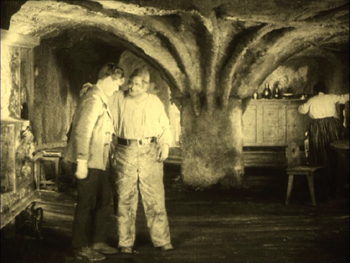 Indeed, Pabst started his directorial career smack in the middle of the Expressionist movement. Der Schatz (The Treasure, 1923; left) is not bad for a debut film, but it was seldom mentioned in the old accounts of the director’s work. It reminds me of such films as Murnau’s Der brennende Acker, with the Expressionist style being used to portray ancient rural buildings. Der Schatz was long impossible to see, at least outside archives in Europe. I remember liking it when I saw it long ago at the Belgian film archive. The new DVD, from Arthaus Premium, is unfortunately entirely in German, with no optional English subtitles. It’s also Region 2 Pal, so those in the US and other non-Region 2 countries would need a multi-standard player. Still, there are plenty of film courses in German departments these days, and this new issue would be invaluable for research and teaching.
Indeed, Pabst started his directorial career smack in the middle of the Expressionist movement. Der Schatz (The Treasure, 1923; left) is not bad for a debut film, but it was seldom mentioned in the old accounts of the director’s work. It reminds me of such films as Murnau’s Der brennende Acker, with the Expressionist style being used to portray ancient rural buildings. Der Schatz was long impossible to see, at least outside archives in Europe. I remember liking it when I saw it long ago at the Belgian film archive. The new DVD, from Arthaus Premium, is unfortunately entirely in German, with no optional English subtitles. It’s also Region 2 Pal, so those in the US and other non-Region 2 countries would need a multi-standard player. Still, there are plenty of film courses in German departments these days, and this new issue would be invaluable for research and teaching.
The print isn’t terrific, but it’s presumably the best available, and it’s watchable. It comes in a nice package with a little booklet and a whole disc of extras—documentaries on the reconstruction of the film (be forewarned, the new version has modern intertitles with a Gothic font) and interviews with experts. The text on the case claims this is the last great work of German Expressionism. That’s a considerable stretch. Die Nibelungen, Tartuffe, Faust, and Metropolis were yet to come, along with some lesser films. Der Schatz can be ordered from Amazon’s German outlet. (For those who have an American Amazon account, this should work just the same way, with the same password and your address and credit-card information on record.)
Far more famous is Pabst’s second film, The Joyless Street. With its controversial subject matter, involving women forced to prostitute themselves in various ways during the era of hyperinflation, the film was repeatedly subject to censors’ cuts—different cuts in different countries. In my first film course ever, in 1970, I remember seeing what was probably the best version available in the USA at the time, but it was far from complete. At least it still retained a pretty good balance between the Greta Garbo and Asta Nielsen plotlines. Later I saw what was probably the original American release print, butchered down to about an hour. The Nielsen plot, where she plays a character who becomes a rich man’s mistress, was all but gone, with the Greta Garbo plot dominating.
Now the Filmmuseum in Munich has released the latest attempt at restoration on DVD. The accompanying booklet, with some lovely illustrations of set designs and toned frames, has one essay in English. Archivist Stefan Drössler traces the attempts to compile a complete version from many different truncated prints. The original German censor’s records, so often a source of original intertitles for such restorations, are not known to survive. A 1989 restoration by Enno Patalas was the first major attempt to assemble something vaguely like the original. Jan-Christopher Horak initiated another restoration in the late 1990s, drawing upon newly surfaced footage from various archives. It was an improvement, but still probably far from the original. The current reconstruction tweaks that version. Still, as Drössler makes clear, with luck this version is only one more step toward a semblance of the original. More prints may surface—even, perhaps a nearly complete one like the miraculous Metropolis print that was, against the odds, found in South America.
In the meantime, the Filmmuseum DVD is as close as we can get to Pabst’s pioneering move into New Objectivity. There’s still about half an hour missing, but at 151 minutes, there’s a lot more of the film than most viewers will have seen before. Again there is a second disc with documentaries on Pabst, including The Other Eye, an overview of his career. This time there are optional English subtitles, though the format is also Pal.
I was very impressed by the film. It’s a network narrative, coincidentally with the same star who played in Hollywood’s quintessential network narrative, Grand Hotel, seven years later. Most of the main characters live on the same street in 1921 Vienna, where the primary centers for interaction are the queue for the butcher’s shop and the brothel hidden behind a dress shop. There are many characters who come and go in complicated scenes. I was also struck by the use of wide-angle lenses and depth staging (as above). Pabst has definitely gone up a notch in my estimation as a result of this release.
More German films
The great actress Asta Nielsen, who was one of the first international movie stars, had already made an incredible number of movies by the time she appeared in The Joyless Street, most of them German productions. Edition Filmmuseum has also released a collection of four short features Nielsen made during the 1910s. The selection was made to show off her range, with two comedies–Das Liebes-ABC (“The ABC of Love,” 1916) and Das Eskimobaby (“The Eskimo Baby,” 1916)–and two dramas–Die Suffragette (1913) and Die Börsenkönigin (“The Queen of the Stock Exchange,” 1918; see top). She worked frequently with emigré Danish director Urban Gad, to whom she was married, but he directed only the third of these four. The others were respectively made by Magnus Stifter, Heinz Schall, and Edmund Edel. (David’s essay on the Danish company Nordisk discusses some of Gad’s films and his 1919 book on filmmaking.) The films average about 60 minutes each.
Although trained as a stage actress, Nielsen had a remarkably flexible, uninhibited acting style onscreen. She wasn’t afraid to play gawky, plain girls but could also convincingly embody a glamorous woman of the world. Some of her films are terrific, some not so much, but they’re always worth watching for her performances.
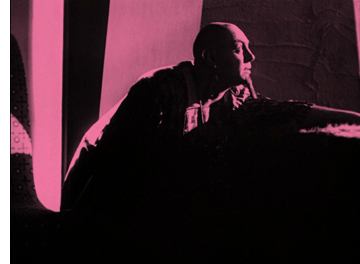 Another recent release is close to my heart, Ernst Lubitsch’s Das Weib des Pharao (1921). In terms of subject matter, it’s not one of his most likable films, with a rather silly plot about a pharaoh falling in love with a commoner. Paul Wegener chews the scenery as a Nubian ruler who wants the pharaoh his daughter instead. But if one can overlook the silliness, it’s a pretty well-made film. The sets are fairly authentic compared with the usual sort of design one encounters in these costume epics, though the notion that a king’s treasure would be inside a giant, hollow statue (see bottom) is pretty risible. Visually, it’s gorgeous, and the print quality in this release is stunning. (There’s a brief film about the restoration, with several of the flashiest shots from the film, here.)
Another recent release is close to my heart, Ernst Lubitsch’s Das Weib des Pharao (1921). In terms of subject matter, it’s not one of his most likable films, with a rather silly plot about a pharaoh falling in love with a commoner. Paul Wegener chews the scenery as a Nubian ruler who wants the pharaoh his daughter instead. But if one can overlook the silliness, it’s a pretty well-made film. The sets are fairly authentic compared with the usual sort of design one encounters in these costume epics, though the notion that a king’s treasure would be inside a giant, hollow statue (see bottom) is pretty risible. Visually, it’s gorgeous, and the print quality in this release is stunning. (There’s a brief film about the restoration, with several of the flashiest shots from the film, here.)
For years, Das Weib existed in only a very choppy, incomplete version running about 40 minutes, discovered at Gosfilmofond, the Soviet/Russian film archive. It was hard to make out the plot. More reels were found in other archives, and a longer version was completed in 2008. Now ALPHA-OMEGA has put together a bang-up package of material. The original score was recorded and matched to the footage to determine a running time of 100 minutes. Footage still missing has, as has become common practice, been filled in with photos, and the plot now makes a lot more sense than it used to. The tinting and toning is based onsurviving footage.
I consider Das Weib extremely important in Lubitsch’s career, as well as in the development of German cinema after World War I. It displays the influence that Hollywood films had on Lubitsch when foreign films were finally let into Germany in 1921 after a nearly five-year ban. To some extent he picked up principles of continuity editing, but it was the new styles of American lighting that he rapidly adopted. He also had the opportunity to work with American cameras and lighting equipment for the first time on Das Weib. The impact of highly directional arc lamps is visible in the frame just above, with its strong back and side light without frontal fill. (I discuss such aspects of Das Weib des Pharao in Herr Lubitsch Goes to Hollywood.)
The extras include the original trailer and a documentary on the restoration. An informative booklet accompanies the disc, including a reprint of program notes I wrote when the film was shown at “Il Giornate del Cinema Muto” in Pordenone. There are optional subtitles in ten languages. The Blu-ray and DVD can be purchased directly from ALPHA-OMEGA. There is no region coding.
Beyond Germany
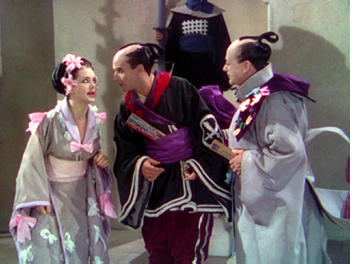 Back in my senior year of high school I heard a recording of The Mikado and instantly became a big Gilbert and Sullivan fan. Coincidentally a film of The Mikado (1967), performed by the D’Oyly Carte Opera Company, came out just at that time. The D’Oyly Carte company had put on the operettas in their original productions in the 1870s, 1880s, and early 1890s and had toured with the same basic productions almost continuously for about 107 years, until forced out of business for lack of funds. The Mikado film was a straightforward record of the theatrical production, filmed on the stage without an audience present. Over the next 15 years or so I was also lucky enough to see some of the plays onstage in Chicago and London. Apart from being charming works, the productions continued to use the same staging and business as when the operettas premiered; they were a living museum of Victorian theatrical practice. Unfortunately the company finally succumbed to financial woes in 1982; there have been sporadic attempts to revive it, but the traditional staging was finally abandoned, and a link to the past was lost.
Back in my senior year of high school I heard a recording of The Mikado and instantly became a big Gilbert and Sullivan fan. Coincidentally a film of The Mikado (1967), performed by the D’Oyly Carte Opera Company, came out just at that time. The D’Oyly Carte company had put on the operettas in their original productions in the 1870s, 1880s, and early 1890s and had toured with the same basic productions almost continuously for about 107 years, until forced out of business for lack of funds. The Mikado film was a straightforward record of the theatrical production, filmed on the stage without an audience present. Over the next 15 years or so I was also lucky enough to see some of the plays onstage in Chicago and London. Apart from being charming works, the productions continued to use the same staging and business as when the operettas premiered; they were a living museum of Victorian theatrical practice. Unfortunately the company finally succumbed to financial woes in 1982; there have been sporadic attempts to revive it, but the traditional staging was finally abandoned, and a link to the past was lost.
I had long been intrigued by the fact that another version of The Mikado had been filmed in Technicolor in 1939, directed by Victor Schertzinger. I was dubious, in that most of the cast were not D’Oyly Carte members. Indeed, the leading tenor role, Nanki-Poo, was played by Kenny Baker, whose main claim to fame at the time was as a featured singer on Jack Benny’s radio show. Still, the film did use three major D’Oyly Carte players: Martin Green, who took the comic baritone roles, in this case Ko-Ko; Sydney Granville, a bass, who plays Pooh-Bah; and Elizabeth Paynter, comic mezzo-soprano, as Pitti-Sing. (From left to right, Paynter, Green, and Granville.) So, when I learned that our friends at the Criterion Collection had put out a restored version on DVD and Blu-ray, I decided to take the plunge and watch it.
It turns out to be a strange mixture. Rather than filming the production onstage, like the later version, the producers created much larger but stylized sets in sound studios; there’s never a hint of an exterior. The blocking and filming are stodgy, and Kenny Baker is barely adequate to his role. I’m not sure this aspect of the film would win converts to the operetta.
On the other hand, there are the marvelous performances of the three D’Oyly Carte actors, particularly Green and Granville, who were among the greatest members of the troupe during its long history. Having a record of this pair in such important roles is a treasure. And Constance Willis, a British stage actress whose only film this was, does an excellent job as Katisha, bringing in a deft humor that one seldom sees in this dour character. Moreover, the postures and gestures are faithful reproductions of the D’Oyly Carte company’s approach. Until the copyrights ran out on the operettas, those who wished to produce them theatrically were given copies of the scripts with all the staging details written in; these had to be followed exactly. The same was true for both film versions of The Mikado. The poses of the young ladies in “Three Little Maids from School,” with mincing gait, tilted heads, and coyly raised arms, are the same ones that all singers playing these roles would have replicated, as the vintage poster shows:
Ko-Ko’s business with his executioner’s ax in his first number, the Mikado’s gestures in “Make the Punishment Fit the Crime,” and many other moments are also historically accurate. The film even includes the traditional encores for two of the most popular numbers, “Here’s a How-De-Do” and “The Flowers that Bloom in the Spring,” though here there is no live audience demanding them. I saw the D’oyly Carte production of The Mikado three times, and these same songs and no others were always encored. Overall, such a record is invaluable, and definitely makes up for the less entertaining portions.
As always, Criterion’s supplements are strong. Apart from some interviews, a silent D’Oyly Carte promotional film, and a booklet by experts, Ko-Ko’s song, “I’ve Got a Little List,” which was cut from the film, is a very welcome addition.
Finally, I’ll just mention that Kino Classics has put out versions of the 1996 restoration of Louis Feuillade’s 1915-16 serial, Les Vampires. Feuillade is a favorite of ours. (For more on his work, see David’s Figures Traced in Light and our entries here and here and here.) Whether in DVD or Blu-ray, Les Vampires is a must-have, providing 417 minutes of pure, crazy pleasure.
Das Weib des Pharao
Sometimes a shot . . .
I Topi Grigi, Chapter 6: Aristocrazia Canaglia.
DB here:
… just knocks you out.
In wrapping up my stay at the Royal Film Archive of Belgium, where I concentrated mostly on German films of the late 1910s and early 1920s, I watched a copy of I Topi Grigi (“The Gray Rats”), a 1918 Italian serial. It’s part of an immense series devoted to the adventures of the cadaverous rogue Za La Mort. Directed by and starring the fascinating Emilio Ghione, it’s in the vein of Fantômas and Les Vampires, though I don’t find it as ingenious or funny or as skillfully directed as Feuillade’s masterpieces.
But then you get those moments. Za La Mort and his young charge Leo are aboard an ocean liner when it’s struck by a torpedo. The passengers panic and make for the lifeboats. It ought to be a spectacular scene reminiscent of Atlantis (1913), but there aren’t many shots devoted to this climax. We see only a few images of people rushing up to the deck from their cabins. The central shot showing the crisis is an image slung along the side of the ship, down the row of lifeboats as people scramble into them. The shot is interrupted by glimpses of men climbing the masts and survivors in the water, but this camera setup is the only one concentrating on the process of getting people offboard.
At first we’re looking down the row of boats, but, as you can tell from my top image, we can’t see much of anything–mostly a man in a nightshirt grabbing the hull of a lifeboat. Then, as the boat is lowered and he has to pull back, we get to see a lot more. Into the slot formed by the lifeboat supports, crisscrossed by ropes and rigging, slip faces and bits of bodies. A woman stoops, a man in silhouette shouts. Meanwhile, a dark-haired woman leans over the railing.
While our young man in the nightshirt sways precariously, the boat continues to descend and we can see even further down the row of lifeboats. A woman in the middle distance calls out. The woman at the railing has started to crawl down the side of the ship.
Now, in the depth of the shot, people are seen trying in vain to pile into the boats. Abruptly, a man on a rope swings into the shot.
The boats are edging away from the ship’s hull–a slight gap emerges in the distance–but we can see passengers still shoving to try to board them.
It’s over for these people. The lifeboats descend, the boy in the nightshirt is still stranded on the side, and the woman who has climbed down beside him vainly stretches out her arm. (See below.)
A new video essay from Flavorpill offers you “135 shots that restore your faith in cinema.” It’s mostly a collection of purty pitchers laced with emblematic moments from classics. But probably you, like me the day before yesterday, haven’t seen Topi Grigi, so my images offer no cosy film-nerd nostalgia. And compared to the Hallmark-Cards aesthetic on display in most of the video essay’s clips, this shot is pretty messy.
But it engages your vision in a dynamic way. It coaxes you to watch a process, in all its scrambling disorder, along a line of sight that emerges, gradually, as uncannily precise. Desperate faces and gestures cascade through a rigid geometry–frames within frames, receding arches like ribbing in a vault, taut diagonals slicing across the frame. Would I trade this concise, rousing, remorseless stream of images for the last forty minutes of Titanic? Yes.
Joseph North offers an admirably detailed chronology and contextualization of the series in his 2011 Masters Thesis, Emilio Ghione and the Mask of Za La Mort. It’s available as a pdf here. Thanks as well to Edward Branigan for alerting me to the Flavorpill video.












